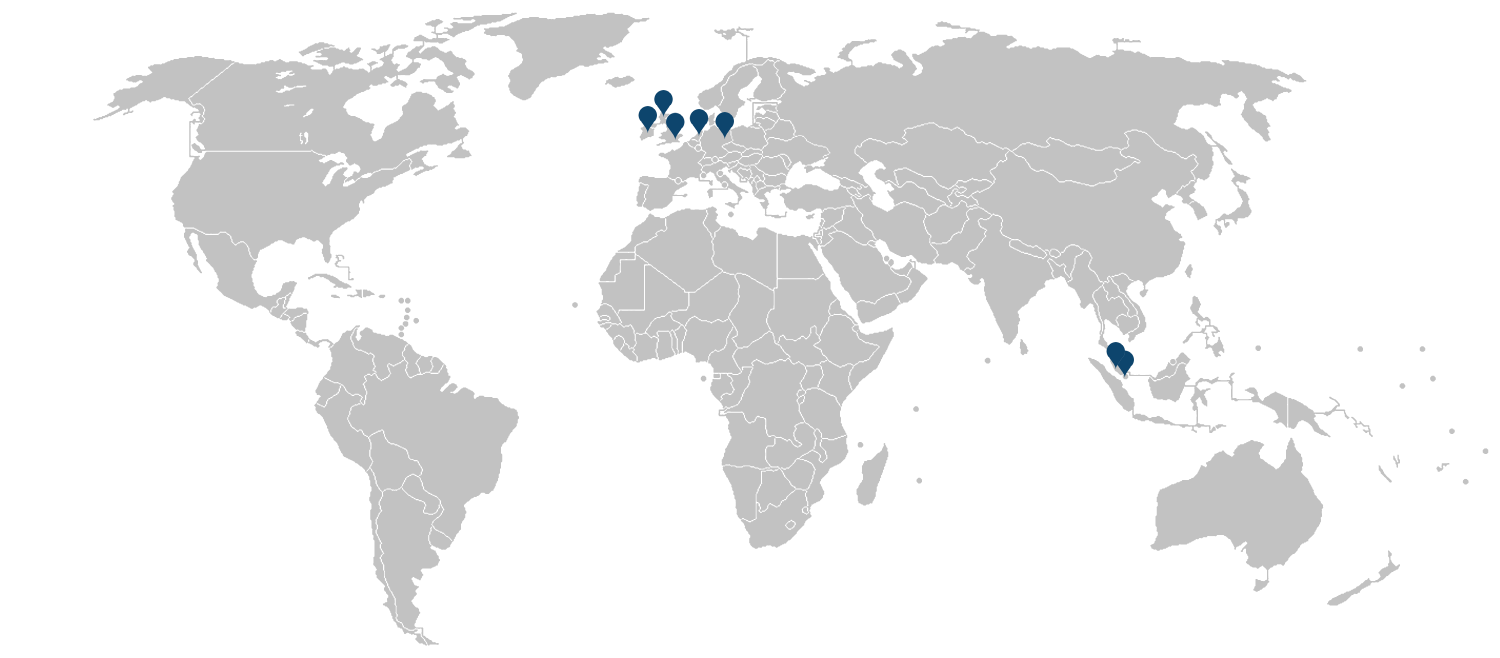Assessing the effectiveness and impact of central bank and supervisory policies in greening the financial system
Assessing the effectiveness and impact of central bank and supervisory policies in greening the financial system
Following consultation with the NGFS to identify emerging research themes and priorities, in March 2020 we published our first targeted call on assessing the impact and effectiveness of policy measures. This cross-cutting theme is a critical issue on the frontier of central bank and financial regulatory action to green the financial system. We received 34 proposals and funded five projects carried out by 20 researchers affiliated with 12 institutions.
Researcher locations

Downloads
Funded projects:
Assessing the effectiveness and impact of central bank and supervisory policies in greening the financial system across Asia
The Paris Agreement established the importance of aligning financial flows with a pathway toward low-carbon and climate-resilient development. In response, central banks and financial supervisors have scaled up sustainable finance measures and are increasingly important stakeholders in climate governance. Due to the contemporary and evolving nature of the topic area, there is a knowledge gap regarding the efficacy of adopted measures and their environmental, social, and economic impacts. It is unclear whether sustainable finance measures are having the intended impact on the financial system and the real economy. Analysis is required to understand:
- The full details of sustainable finance measures that have been implemented;
- The rationales and processes underpinning their adoption; and
- The effectiveness, efficiency, and equity of adopted measures, from the perspective of both financial institutions and supervisors.
We address this knowledge gap, focusing specifically on Asia, where many countries have adopted sustainable finance measures. Asia has global relevance as it contains many countries with the largest or rapidly increasing greenhouse gas emissions levels. We employ a sequential research design, utilising both quantitative and qualitative methods to collect primary data. Key elements of the research will be two written surveys with central banks and supervisors, and banking institutions, respectively, as well as detailed follow-up interviews with both groups.
Our research improves understanding of the progress made toward aligning financial systems and flows with the Paris Agreement. It will highlight cases where measures taken by central banks or supervisors have led to measurable positive outcomes, in terms of contributing to the transition to a low-carbon and climate-resilient economy or managing transition and physical risks. It will provide recommendations on data gathering by central banks to enhance their evaluation of the effectiveness of sustainable finance measures. It will provide policy guidance so countries can improve the design and implementation of existing and new measures, thereby enhancing the capacity of central banks.
Show LessImplications for Emissions, Investment, and Inflation
Over recent years several instruments for green central bank monetary policy have been proposed but little to no modelling rigour has been applied to further substantiate the debate. We draw on theoretical modelling and numerical simulation to assess two specific proposals of green monetary policy: the greening of central bank collateral frameworks, and targeted green refinancing operations. We hope to deepen our theoretical understanding of these instruments and quantify their impact on the economy and environment. To do so, we draw on formal modelling that can account for cumulative emissions, differentiated investment (based on carbon emissions), economic growth, monetary policy, and inflation.
Our model will be the first to integrate all of these five aspects which are all essential to our research question. The inclusion of monetary policy is self‐explanatory. However, the final requirement, inflation, is often neglected within climate policy analysis. Within the context of green monetary policy, inflation becomes particularly important as it is the principle aim of modern central bank mandates and climate change might create “cost‐push” or “demand‐pull” inflation.
In order to inform policymakers of the potential effects of green collateral frameworks and green refinancing operations, we propose including inflation and monetary policy into a dynamic general equilibrium model that includes a banking model, differentiated sectors (based on carbon emissions), and conventional climate polity. In addition to observing the effects of green monetary policy on emissions and investment, this model would also allow us to analyse the potential trade‐off between climate change mitigation and inflation, which might have large-scale ramifications for social welfare.
Show LessQuantifying the impact of green monetary and supervisory policies on the energy transition
As we transition our economies to a low-carbon path, climate-related transition risks to the financial sector pose a challenge to policymakers in their policy design. Central banks can play an essential role in facilitating a successful transition by directing the funds needed to achieve this transition in a timely manner and thus reducing systemic risks. However, any intervention by central banks should be evaluated across sectors and across scenarios in order to guarantee effectiveness, efficiency, and coherence with fiscal policies.
Our methodology is scenario analysis based on a modified Computable General Equilibrium model, which allows us to capture feedback loops across sectors, along with tracking the change in prices and quantities following an exogenous change in policies, technologies, or consumer preferences. Moreover, in order to capture both risks and opportunities associated with the transition process, our model distinguishes between clean and dirty subsectors. It also uses sector-specific capital stocks, which allows us to differentiate the cost of capital across sectors and scenarios. The model output includes quantitative effects of exogenous policy change on cash flows, return on invested capital, asset values, price levels, inflation, and many other variables across modelled sectors and scenarios. Such information can be used to stress test investment portfolios and financial stability under different monetary, supervisory, and fiscal interventions. We believe that our approach is an innovative one that contributes to answering key questions about the impacts of central banks’ policies and operations on the costs of different pathways for the energy transition, through both the performance of the financial system and the possible changes in the real economy.
Show LessThe Financial Geography of Green Finance Policy: Evaluating Policy Effectiveness across over 50 countries
In the past decade, over 390 finance policy initiatives aimed at greening the financial sector have been spearheaded by various public authorities around the world. So far, scholarship has offered insights into how traditional environmental policy such as carbon taxes, emission trading schemes, or low carbon R&D subsidies impact green financing, innovation, and financial performance. However, we still know surprisingly little about the impact of green finance policies on the real economy and the financial sector itself. In particular, we run major knowledge and policy deficits in managing climate risks in primary capital markets. Furthermore, we still have a limited understanding of the effectiveness of green finance measures and how they interact with other existing environmental policy regimes across countries; particularly how they might be undercut by subsidy regimes towards emissions-intensive industries that governments pursue in parallel.
We address this gap by conducting an in-depth mapping of green finance policies and traditional environmental policy instruments across more than 50 countries. We propose to quantitatively analyse the impact of extant green finance policies in shifting capital towards green solutions and away from emission-intensive activities. These objectives will be achieved via a three-pronged approach:
- Analyzing the largest datasets on sustainable finance policy initiatives and instruments,
- Interviewing NGFS members, and
- Analyzing a comprehensive global dataset of syndicated loans, equity, and bond issuances.
Our research seeks to inform and enhance the capacity of central banks and financial supervisors to implement effective green capital market policies that are well-adapted to broader policy and subsidy regimes. In addition, we will discuss the implications of more stringent capital market regulation for just transition outcomes.
Show LessOutputs
Climate change and central bank asset purchases: An empirical investigation for the euro area and the UK
The aim of this project is to provide the first integrated analysis of how the corporate asset purchases of the Bank of England and the European Central Bank can become climate-aligned, as well as the impact that this could have on economic/financial factors and emissions. We explore the implications of two different approaches for the incorporation of climate issues into central bank asset purchases: (i) the ‘climate footprint’ approach whereby the asset purchases are adjusted based on the climate performance of the bond issuers and (ii) the ‘climate risk’ approach in which the recalibration of asset purchases relies on the exposure of companies to climate risks under different climate scenarios.
For each approach, we explore several options that include both the ‘tilting’ of purchases and the exclusion/inclusion of corporate bonds. In the case of the ‘climate footprint’ approach, the adjustment of purchases relies on the combined use of backward-looking and forward-looking metrics about the emissions of companies and other environmental factors. In the ‘climate footprint’ approach, the adjustment is based on the credit risk that the bond issuers face under the NGFS climate scenarios. We use econometric techniques to investigate the potential effects of the different policy options on the climate performance of bond issuers.
Show Less
















